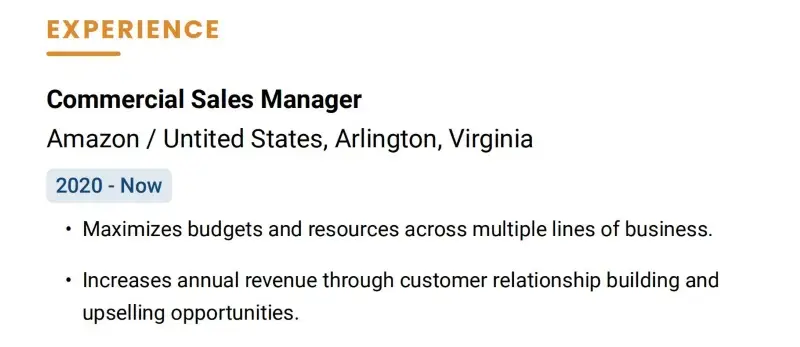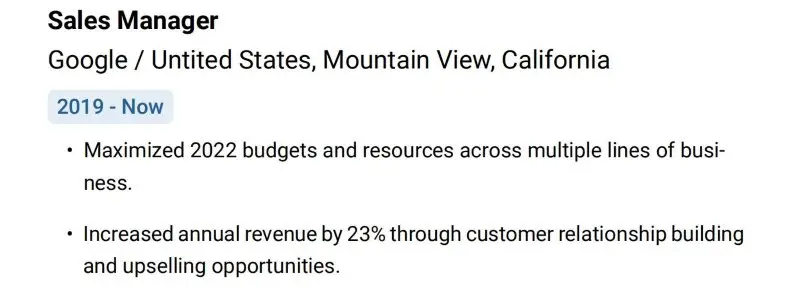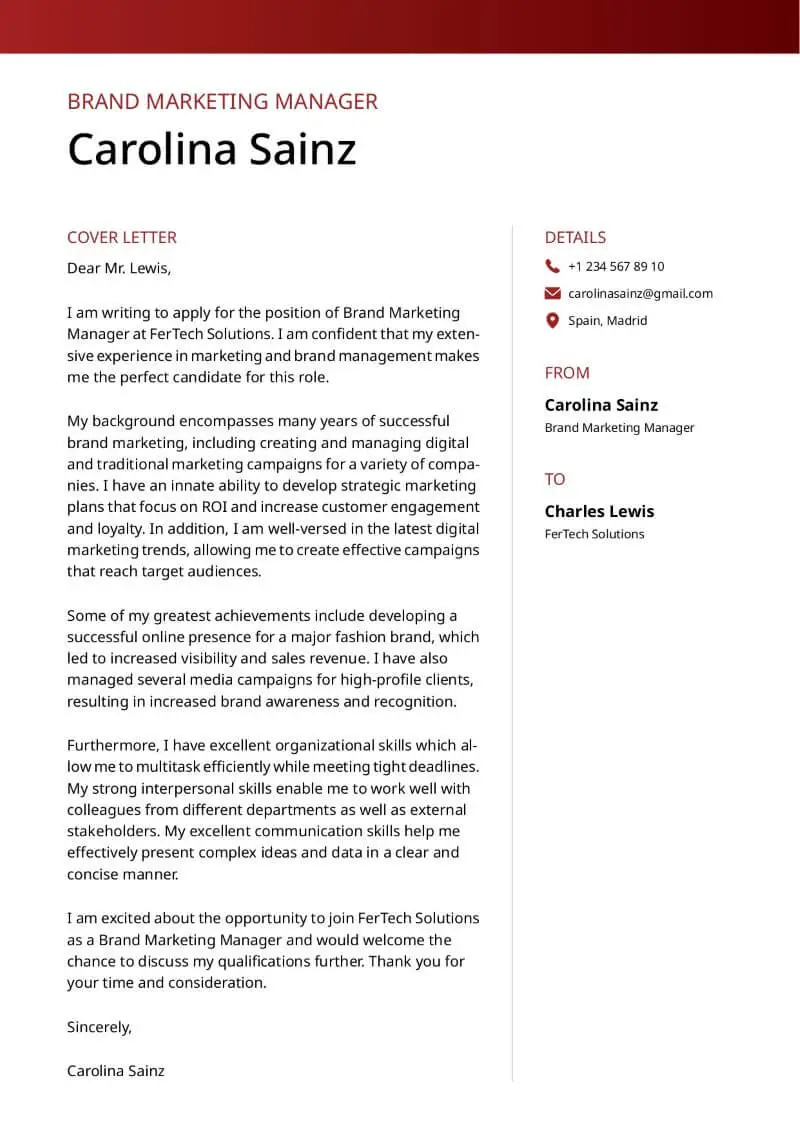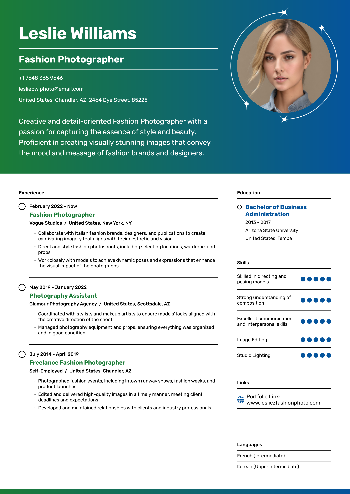Your resume is more than just a document - it's the first impression you make on potential employers. Using action verbs on your resume can make that impression memorable.
Writing about yourself is seldom an easy task, yet it comes up again and again throughout your professional career. From the "Tell me about yourself" interview question to networking, it seems like you constantly have to describe who you are.
All too often, whether it be during in-person, online, or written interactions, professionals struggle to paint themselves in the best light. Even if they are the best person for a project or task.
Don’t sell yourself short, you are your best asset.
Nothing encapsulates this more than your resume. After all, it's your elevator pitch, career, accomplishments, education, and more all in just one or two pages. It represents your professional brand and the value you create.
However, so many resumes are brought down by basic language like "use", "made", "helped", and others. While these are perfectly fine for day-to-day conversation, such simplistic language can only hurt this vital document.
It's nothing a few resume action verbs can't fix.
A review of over 175,000 resumes showed that 93% of them used at least one "action" word. However, only about a third used more than 10.
But, what constitutes an "action verb"? How should you use them and how often?
Let's dive a little deeper into this vital part of speech as it pertains to getting you that job you've always wanted.
What is an action verb?
Resume action verbs are powerful and descriptive words used to convey specific achievements, responsibilities, or skills.
These words serve to actively demonstrate your capabilities and accomplishments, rather than simply listing tasks or duties. By starting each bullet point with a strong action verb, you immediately grab the reader's attention and showcase your proactive approach to work.
They infuse your resume with energy and impact, helping you stand out from other candidates by highlighting your contributions and potential.
The superior man acts before he speaks, and afterward speaks according to his actions.
Why do I need to use action verbs for a resume?
You might be saying "I need to share what my responsibilities were to match the job description and get past ATS". And you're right.
But, imagine for a moment, that you are a hiring manager reading someone's resume. You have to decide whether to invite this candidate to a job interview or not. Which sounds better?
Option 1:
Spearheaded a 12-person, cross-functional team through continuous improvement projects.
Option 2:
Responsible for a large team of professionals from multiple departments.
Both options communicate the "interdisciplinary team leadership" responsibility you would find in a job description. But, by using the action verb "spearheaded", you are able to place yourself in an active role where you are in the driver's seat.
Additionally, it invites curiosity:
- "Option 2" is generic, therefore it prompts a fundamental (and boring) question: "So what"?
- "Option 1" communicates your involvement and enables you to dive deeper into the responsibility, transforming it into an accomplishment. It invites the "How?" and "Why?" to be asked.
Those are the questions you need to answer throughout your professional resume template to differentiate yourself from other applicants. This will engage hiring managers and impress a potential employer.
Resumes that use action verbs increase your chances of getting an interview by 140%.
How to use action verbs?
Using an online AI resume editor can indeed simplify the writing process and allow you to focus on choosing effective words for a resume.
Create your professional Resume in 10 minutes for FREE
Build My Resume
A resume creator will take care of the formatting, allowing you to place more emphasis on the content, including your choice of powerful action verbs.
This will help you create a resume that effectively showcases your qualifications to potential employers.
Every sentence and bullet point in your resume should start with strong action verbs.
As with everything in a career search, there are some additional best practices to follow to convey you as a highly communicable professional.
Past vs. Present
While a simple detail, always double-check that your verb tense is correct for any given section.
For your professional summary, action verbs should always be in the present tense. They communicate the value you can add to an organization immediately.
For your current position(s), the verbs should also be in the present tense... for the most part. An action verb in the present tense describes something you are actively completing. For example:

However, if you are describing what you have already accomplished in your present position, you would use a past tense verb:

It is also useful to group the bullets by verb tense to enhance readability. If not employing a paragraph-style position description, consider placing all of the past tense bullets first. In this method, a more narrative structure is formed while also highlighting your top accomplishments as the first bullets of a section.
It's often more important to share what you have achieved rather than what you are achieving.
For all previous positions, powerful resume words should be uses in the past tense.
Variety is the Spice of Life
The ability to collaborate is essential in every professional position, as evidenced by collaboration's inclusion in most job postings. So, naturally, you want to highlight your previous collaborations as an achievement. Perhaps it's collaboration with an executive, collaboration with a peer, or collaboration with a client.
Do you notice a problem with that paragraph? Something repetitive and ever-so-slightly annoying?
Some form of "collaborate" is used six times in just three sentences. It removes the power from otherwise good action verbs for a resume.
While it's exaggerated for effect here, there are still implications to using the same action verb multiple times throughout your resume. This not only disengages the reader, but makes it appear as though you didn't put as much effort into customizing the document as you should have.
To avoid this unintended side effect:
- Never use an action verb more than once per position.
- Limit your use of a particular action verb to twice in a one-page resume and three to four times in a two-page resume.
It's time to bust out that thesaurus! Leverage other powerful resume words to communicate the same idea without becoming a broken record.
Taking Action Verbs Too Far
Don't get too fancy - you want your resume to read at about a high school junior-to-senior level.
While this may seem counterintuitive, hiring managers only spend about seven seconds on the initial scan of your resume. Your diction and sentence structure must be easy to understand to entice the recruiter to examine your resume further.
Action words are not limited to just the work experience section. They can and should also be used in a resume objective or skills and accomplishments sections.
You want to sound educated, but not pretentious. Prioritize words that would sound appropriate for an interview.
Good action verbs for resume:
- Merged;
- Distributed;
- Reduced;
- Streamlined;
- Facilitated;
- Enhanced.
Inappropriate action verbs for resume:
- Amalgamated;
- Decentralized;
- Abated;
- Conflated;
- Obfuscated;
- Diminished.
Listless Lists
Whenever possible, quantify your achievements using numbers, percentages, or other measurable metrics. This makes your accomplishments more impactful.
With this, you also want to limit how many action verbs you use in a sentence. As a rule of thumb, try to avoid using more than 2 action verbs next to each other. The more you use, the harder the sentence becomes to understand and the less impact each verb has.
Consider the following example:
- Recruited, interviewed, evaluated, hired, onboarded, and trained the newly established Sales department.
While this bullet fully communicates your achievement, it does so in a very surface-level manner and is slightly overwhelming to the reader. By that sixth verb, the HR just wants you to get to the point.
If you do want to highlight each verb, consider separating the single bullet into multiple bullets. It is also possible to utilize the verbs as other parts of speech.
For example:
- Recruited and hired potential talent for the newly established Sales department, conducting interviews, performance evaluations, and training to accelerate onboarding.
The above sentence varies makes readability a priority while still injecting all those necessary keywords and showing the relationships between your responsibilities.
Varying your sentence structures when using strong action verbs for a resume creates a dynamic. Plus, it answers all the questions the hiring manager might have.
| Question | Answer |
|---|---|
| What? | Recruited and hired potential talent. |
| Where? | Newly established Sales department. |
| How? | Interviews, performance evaluations, and training. |
| Why? | To accelerate onboarding. |
| Result? | Improved team productivity by 35% within the first quarter. |
Don't use action verbs only for your resume
Cover Letters
It is recommended to start with an action verb not only every bullet point of your resume. Every sentence of your cover letter should also contain an action verb. It is still an official career document that develops your professional brand.
Adhere to the same rules you would on a resume regarding verb tense, frequeing verb tense, frequeing verb tense, frequency, and readability.
Here's an example of a cover letter that employs action verbs to display the candidate as the most qualified individual:

LinkedIn Profiles
Your online professional presence is no different when it comes to using engaging, dynamic verbs to present yourself.
While it is completely appropriate to use action verbs throughout your LinkedIn profile, you can use more simplified language in key sections.
For example, the "About" section should be primarily targeted at human eyes, rather than being maximized to increase your LinkedIn searchability. As a result, emphasize readability to raise engagement.
Concerning a ratio, try to aim for 85% elevated and 15% everyday verbs. This will still communicate you are a professional who is to be taken seriously, but also that you are a human capable of creating relationships and building a network.
Here's a snippet from a LinkedIn section that mixes multiple types of powerful action verbs to its advantage:
For me, working with data is like solving a complex puzzle that requires ingenuity, logic, and creativity. Any given initiative starts with using data streams to solidify my knowledge of business workflows. This helps me conduct detailed analyses and prove the ROI of a newly launched feature.
However, it is critical that you still employ verbs that communicate some type of action, even if more conversational in tone.
Interviews
Just as with a LinkedIn profile, your diction during job interviews should incorporate action verbs. However, they must come off as natural and appropriate.
Within the first few seconds of an interview, the hiring manager often forms initial impressions based on the candidate's appearance and body language.
Think about how you speak in a professional setting while matching your language to the position you are applying to. After all, the speech of a CEO is going to be very different than that of a recent college graduate.
So, if you are a 20-something in the midst of a job search, using 4 and 5-syllable action words will make your answers sound rehearsed. Even when you are a 25-year C-level executive, an overuse of strong action verbs will only hurt you.
A lot of us are very good at our jobs but absolutely hopeless at job interviews.
Instead of placing extra pressure on yourself to sound smart during an already stressful situation, focus on using words, no matter how simple, that communication dynamic action. Emphasize the "How" rather than the "What".
Customizing action verbs for ATS
An Applicant Tracking System (ATS) is software used by employers and hiring managers to streamline the recruitment process. It allows companies to collect, organize, and manage job applications electronically.
ATS algorithms often look for specific action verbs that match the job requirements and descriptions provided by employers.
For example, if a job posting emphasizes skills like "leadership", "communication", or "problem-solving", the ATS may prioritize resumes that contain corresponding action verbs such as "led", "communicated", or "solved".
Tips to help you use action verbs effectively:
- Read job description. Review the job posting carefully and identify key skills and qualifications sought by the employer. Use action verbs that reflect these keywords.
- Avoid passive voice. Opt for active voice verbs that convey direct action and accountability. Passive voice can make your statements sound less engaging and impactful. For instance, use "managed" instead of "was responsible for managing".
- Be concise and specific. Choose action verbs that succinctly describe your responsibilities and accomplishments. ATS often look for exact matches between the resume and job description, so clarity is key.
- Format your resume. Ensure that your resume includes all important resume sections and follows standard formatting guidelines to prevent compatibility issues with ATS software. Avoid using headers, footers, images, or unusual fonts that could cause parsing errors.
By incorporating these tips, you can optimize your resume with action verbs that are both compatible with ATS software and compelling to human recruiters.
175 examples of action verbs for a resume
To help you create an amazing resume with highly dynamic words, here is an action verbs list for your resume. These are just some of the numerous words for a resume you can use to engage hiring managers and recruiters.
To communicate 25 different job skills across teamwork, leadership, and value, each column is a synonym of the header that you would likely see in a job posting.
Remember! If the job posting uses "partner" instead of "collaborate", consider changing any bullet that starts with "collaborated" to "partnered" to maximize your ATS friendliness!
List of action verbs for your resume:
| Collaborated | Researched | Organized | Improved | Led |
|---|---|---|---|---|
| Partnered | Investigated | Coordinated | Boosted | Oversaw |
| Teamed | Studied | Standardized | Increased | Represented |
| Cooperated | Tested | Planned | Accelerated | Steered |
| Co-acted | Explored | Systematized | Enhanced | Piloted |
| Affiliated | Experimented | Compiled | Upgraded | Drove |
| Synergized | Analyzed | Arranged | Refined | Orchestrated |
| Developed | Mentored | Advised | Created | Analyzed |
|---|---|---|---|---|
| Designed | Coached | Consulted | Activated | Evaluated |
| Advanced | Trained | Informed | Crafted | Inspected |
| Refined | Motivated | Apprised | Generated | Examined |
| Grew | Equipped | Counseled | Produced | Assessed |
| Promoted | Instructed | Guided | Fabricated | Measured |
| Engineered | Facilitated | Enlightened | Invented | Interpreted |
| Adapted | Executed | Achieved | Reduced | Facilitated |
|---|---|---|---|---|
| Altered | Conducted | Accomplished | Lowered | Enabled |
| Modified | Finalized | Secured | Consolidated | Streamlined |
| Converted | Completed | Attained | Reconciled | Simplified |
| Tailored | Delivered | Exceeded | Eliminated | Authorized |
| Customized | Implemented | Surpassed | Minimized | Empowered |
| Revised | Operationalized | Fulfilled | Curtailed | Mobilized |
| Combined | Conceptualized | Directed | Maximized | Constructed |
|---|---|---|---|---|
| Amalgamated | Innovated | Delegated | Optimized | Assembled |
| Blended | Synthesized | Controlled | Allocated | Manufactured |
| Merged | Devised | Sponsored | Perfected | Formed |
| Incorporated | Originated | Administered | Augmented | Forged |
| Homogenized | Revolutionized | Supervised | Elevated | Modeled |
| Fused | Imagined | Coordinated | Amplified | Engineered |
| Updated | Aligned | Supported | Launched | Revitalized |
|---|---|---|---|---|
| Modernized | Integrated | Contributed | Debuted | Transformed |
| Evolved | Harmonized | Participated | Initiated | Reshaped |
| Renovated | Oriented | Bolstered | Instituted | Strengthened |
| Refreshed | United | Reinforced | Established | Renewed |
| Revised | Regulated | Aided | Introduced | Reinvigorated |
| Upgraded | Streamlined | Sustained | Unveiled | Reinvented |
Action verbs list by industry
| Industry | Action Verbs |
|---|---|
| Business & Management | Achieved, Analyzed, Coordinated, Developed, Directed, Enhanced, Established, Evaluated, Facilitated, Improved, Managed, Negotiated, Optimized, Strategized |
| Sales & Marketing | Advertised, Closed, Created, Designed, Engaged, Generated, Launched, Marketed, Promoted, Researched, Sold, Trained, Upsold |
| Information Technology | Administered, Automated, Configured, Constructed, Debugged, Diagnosed, Engineered, Integrated, Programmed, Troubleshot, Updated, Validated, Wired |
| Finance & Accounting | Audited, Balanced, Budgeted, Forecasted, Monitored, Planned, Reconciled, Reported, Streamlined, Tracked, Valued, Yielded |
| Healthcare | Assessed, Diagnosed, Educated, Evaluated, Facilitated, Implemented, Monitored, Performed, Prescribed, Researched, Scheduled, Supported, Treated, Verified |
| Education | Advocated, Collaborated, Enhanced, Instructed, Mentored, Organized, Presented, Supervised, Taught, Tutored, Updated |
| Engineering & Manufacturing | Assembled, Fabricated, Innovated, Optimized, Processed, Prototyped, Refined, Tested, Upgraded |
| Creative Arts & Media | Articulated, Conceptualized, Curated, Illustrated, Photographed, Produced, Rendered, Scripted, Styled, Visualized, Wrote, Edited |
| Customer Service | Addressed, Delivered, Engaged, Helped, Resolved, Responded, Supported, Updated, Managed, Facilitated |
| Research & Development | Conducted, Designed, Discovered, Innovated, Investigated, Modeled, Published, Synthesized, Tested, Validated, Analyzed, Experimented |
| Human Resources | Collaborated, Developed, Facilitated, Hired, Implemented, Interviewed, Mediated, Organized, Resolved, Promoted |
| Hospitality & Food Service | Catered, Enhanced, Managed, Prepared, Served, Welcomed, Scheduled, Resolved, Coordinated |
Conclusion
In the competitive world of job hunting, a great resume can be the key to unlocking the best career opportunities.
So, take the time to choose your action verbs for your resume wisely to showcase your achievements. Your resume will stand out from the crowd, opening doors to your next great career position.
Create your professional Resume in 10 minutes for FREE
Build My Resume















